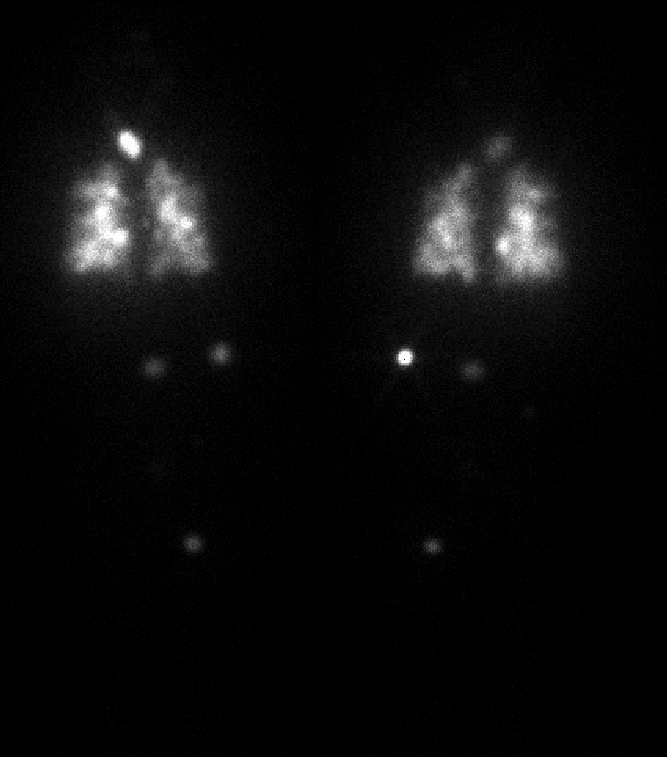Case Author(s): Yungao Ding, M.D., PhD and Barry A. Siegel, M.D. , 5/11/2001 . Rating: #D2, #Q3
Diagnosis: Widespread metasitasis of thyroid cancer
Brief history:
58-year-old woman with a past history of thyroid cancer presents with dyspnea
Images:

Anterior (left) and posterior (right) I-131 whole-body images
View main image(tr) in a separate image viewer
View second image(xr).
Posteroanterior chest radiograph
View third image(tr).
Anterior (left) and posterior (right) I-131 whole-body images obtained five years ago
Full history/Diagnosis is available below
Diagnosis: Widespread metasitasis of thyroid cancer
Full history:
This 58-year-old woman with papillary carcinoma of the thyroid underwent thyroidectomy in October 1995 and subsequent I-131 ablation of residual thyroid tissue in November 1995. The patient had no subsequent treatment and was lost to follow-up. She recently developed dyspnea and came to the emergency department, where a chest radiograph (Image 2) showed innumerable pulmonary nodules of varying sizes, consistent with widespread pulmonary metastases. She was then referred for I-131 whole-body imaging.
Radiopharmaceutical:
5.2 mCi I-131 sodium idide, p.o.
Findings:
The calculated 72-hour whole body retention of I-131 is 46%. The whole-body images show intense, heterogenously increased activity diffusely throughout both lungs, consistent with the widespread pulmonary metastases as demonstrated on chest radiograph. Intense I-131 uptake is also noted in the right side of the neck, either in the thyroid bed or cervical lymph nodes. Additional foci of I-131 accumulation are seen in the pelvis and lower extremities consistent with multifocal osseous metastases. The bone lesions were not evident on radiographs (not shown). The whole-body I-131 images obtained at the time of ablation of residual thyroid tissue five years previously (Image 3) only showed residual thyroid tissue in
Discussion:
Papillary thyroid cancer accounts for about 60% of all thyroid carcinomas; the incidence peaks in the 5th decade and the disease is more common in women than in men. The tumor is unencapsulated and most often well differentiated. Most papillary carcinomas contain some follicular elements. The cancer metastasizes to regional lymph nodes and hematogenously to lungs and bones (rare). Tumor foci usually concentrate iodine and can be
Followup:
The patient was subsequently treated with 50 mCi I-131. This relatively low dose of I-131 was chosen because of the potential for respiratory complications given the extensive pulmonary metastases. The patient developed worsening dyspnea necessitating admission to the hospital three days after I-131 therapy
Major teaching point(s):
This cases emphasizes the importance of routine medical follow-up after treatment of thyroid cancer even in the absence of symptoms or signs suggesting recurrence.
ACR Codes and Keywords:
References and General Discussion of Thyroid Scintigraphy (Anatomic field:Face, Mastoids, and Neck, Category:Neoplasm, Neoplastic-like condition)
Search for similar cases.
Edit this case
Add comments about this case
Return to the Teaching File home page.
Case number: tr016
Copyright by Wash U MO

